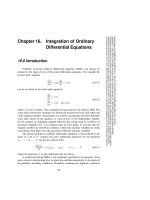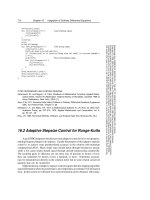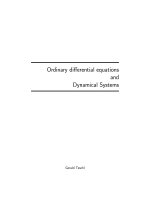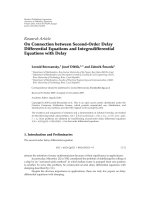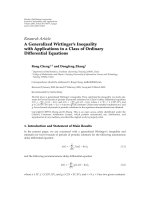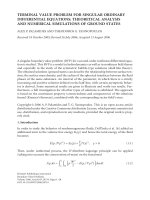ordinary differential equations and dynamical systems - g. teschl
Bạn đang xem bản rút gọn của tài liệu. Xem và tải ngay bản đầy đủ của tài liệu tại đây (2.36 MB, 237 trang )
Ordinary differential equations
and
Dynamical Systems
Gerald Teschl
Gerald Teschl
Institut f¨ur Mathematik
Strudlhofgasse 4
Universit¨at Wien
1090 Wien, Austria
E-mail:
URL: />1991 Mathematics subject classification. 34-01
Abstract. This manuscript provides an introduction to ordinary differential
equations and dynamical systems. We start with some simple examples
of explicitly solvable equations. Then we prove the fundamental results
concerning the initial value problem: existence, uniqueness, extensibility,
dependence on initial conditions. Furthermore we consider linear equations,
the Floquet theorem, and the autonomous linear flow.
Then we establish the Frobenius method for linear equations in the com-
plex domain and investigates Sturm–Liouville type boundary value problems
including oscillation theory.
Next we introduce the concept of a dynamical system and discuss sta-
bility including the stable manifold and the Hartman–Grobman theorem for
both continuous and discrete systems.
We prove the Poincar´e–Bendixson theorem and investigate several ex-
amples of planar systems from classical mechanics, ecology, and electrical
engineering. Moreover, attractors, Hamiltonian systems , the KAM theorem,
and periodic solutions are discussed as well.
Finally, there is an introduction to chaos. Beginning with the basics for
iterated interval maps and ending with the Smale–Birkhoff theorem and the
Melnikov method for homoclinic orbits.
Keywords and phrases. Ordinary differential equations, dynamical systems,
Sturm-Liouville equations.
Typeset by A
M
S-L
A
T
E
X and Makeindex.
Version: February 18, 2004
Copyright
c
2000-2004 by Gerald Teschl
Contents
Preface vii
Part 1. Classical theory
Chapter 1. Introduction 3
§1.1. Newton’s equations 3
§1.2. Classification of differential equations 5
§1.3. First order autonomous equations 8
§1.4. Finding explicit solutions 11
§1.5. Qualitative analysis of first order equations 16
Chapter 2. Initial value problems 21
§2.1. Fixed point theorems 21
§2.2. The basic existence and uniqueness result 23
§2.3. Dependence on the initial condition 26
§2.4. Extensibility of solutions 29
§2.5. Euler’s method and the Peano theorem 32
§2.6. Appendix: Volterra integral equations 34
Chapter 3. Linear equations 41
§3.1. Preliminaries from linear algebra 41
§3.2. Linear autonomous first order systems 47
§3.3. General linear first order systems 50
§3.4. Periodic linear systems 54
iii
iv Contents
Chapter 4. Differential equations in the complex domain 61
§4.1. The basic existence and uniqueness result 61
§4.2. Linear equations 63
§4.3. The Frobenius method 67
§4.4. Second order equations 70
Chapter 5. Boundary value problems 77
§5.1. Introduction 77
§5.2. Symmetric compact operators 80
§5.3. Regular Sturm-Liouville problems 85
§5.4. Oscillation theory 90
Part 2. Dynamical systems
Chapter 6. Dynamical systems 99
§6.1. Dynamical systems 99
§6.2. The flow of an autonomous equation 100
§6.3. Orbits and invariant sets 103
§6.4. Stability of fixed points 107
§6.5. Stability via Liapunov’s method 109
§6.6. Newton’s equation in one dimension 110
Chapter 7. Local behavior near fixed points 115
§7.1. Stability of linear systems 115
§7.2. Stable and unstable manifolds 118
§7.3. The Hartman-Grobman theorem 123
§7.4. Appendix: Hammerstein integral equations 127
Chapter 8. Planar dynamical systems 129
§8.1. The Poincar´e–Bendixson theorem 129
§8.2. Examples from ecology 133
§8.3. Examples from electrical engineering 137
Chapter 9. Higher dimensional dynamical systems 143
§9.1. Attracting sets 143
§9.2. The Lorenz equation 146
§9.3. Hamiltonian mechanics 150
§9.4. Completely integrable Hamiltonian systems 154
§9.5. The Kepler problem 159
Contents v
§9.6. The KAM theorem 160
Part 3. Chaos
Chapter 10. Discrete dynamical systems 167
§10.1. The logistic equation 167
§10.2. Fixed and periodic points 170
§10.3. Linear difference equations 172
§10.4. Local behavior near fixed points 174
Chapter 11. Periodic solutions 177
§11.1. Stability of periodic solutions 177
§11.2. The Poincar´e map 178
§11.3. Stable and unstable manifolds 180
§11.4. Melnikov’s method for autonomous perturbations 183
§11.5. Melnikov’s method for nonautonomous perturbations 188
Chapter 12. Discrete dynamical systems in one dimension 191
§12.1. Period doubling 191
§12.2. Sarkovskii’s theorem 194
§12.3. On the definition of chaos 195
§12.4. Cantor sets and the tent map 198
§12.5. Symbolic dynamics 201
§12.6. Strange attractors/repellors and fractal sets 205
§12.7. Homoclinic orbits as source for chaos 209
Chapter 13. Chaos in higher dimensional systems 213
§13.1. The Smale horseshoe 213
§13.2. The Smale-Birkhoff homoclinic theorem 215
§13.3. Melnikov’s method for homoclinic orbits 216
Bibliography 221
Glossary of notations 223
Index 225
Preface
The present manuscript constitutes the lecture notes for my courses Ordi-
nary Differential Equations and Dynamical Systems and Chaos held at the
University of Vienna in Summer 2000 (5hrs.) and Winter 2000/01 (3hrs),
respectively.
It is supposed to give a self contained introduction to the field of ordi-
nary differential equations with emphasize on the view point of dynamical
systems. It only requires some basic knowledge from calculus, complex func-
tions, and linear algebra which should be covered in the usual courses. I tried
to show how a computer system, Mathematica, can help with the investiga-
tion of differential equations. However, any other program can be used as
well.
The manuscript is available from
/>Acknowledgments
I wish to thank my students P. Capka and F. Wisser who have pointed
out several typos and made useful suggestions for improvements.
Gerald Teschl
Vienna, Austria
May, 2001
vii
Part 1
Classical theory
Chapter 1
Introduction
1.1. Newton’s equations
Let us begin with an example from physics. In classical mechanics a particle
is described by a point in space whose location is given by a function
x : R → R
3
. (1.1)
The derivative of this function with respect to time is the velocity
v = ˙x : R → R
3
(1.2)
of the particle, and the derivative of the velocity is called acceleration
a = ˙v : R → R
3
. (1.3)
In such a model the particle is usually moving in an external force field
F : R
3
→ R
3
(1.4)
describing the force F (x) acting on the particle at x. The basic law of
Newton states that at each point x in space the force acting on the particle
must be equal to the acc eleration times the mass m > 0 of the particle, that
is,
m ¨x(t) = F (x(t)), for all t ∈ R. (1.5)
Such a relation between a function x(t) and its derivatives is called a differ-
ential equation. Equation (1.5) is called of second order since the highest
derivative is of second degree. More precisely, we even have a system of
differential equations since there is one for each coordinate direction.
In our case x is called the dependent and t is called the independent
variable. It is also possible to increase the number of dependent variables
3
4 1. Introduction
by considering (x, v). The advantage is that we now have a first order system
˙x(t) = v(t)
˙v(t) =
1
m
F (x(t)). (1.6)
This form is often better suited for theoretical investigations.
For given force F one wants to find solutions, that is functions x(t) which
satisfy (1.5) (respectively (1.6)). To become more spec ific, let us look at the
motion of a stone falling towards the earth. In the vicinity of the surface
of the earth, the gravitational force acting on the stone is approximately
constant and given by
F (x) = −m g
0
0
1
. (1.7)
Here g is a positive constant and the x
3
direction is assumed to be normal
to the surface. Hence our system of differential equations reads
m ¨x
1
= 0,
m ¨x
2
= 0,
m ¨x
3
= −m g. (1.8)
The first equation can be integrated with respec t to t twice, resulting in
x
1
(t) = C
1
+ C
2
t, where C
1
, C
2
are the integration constants. Computing
the values of x
1
, ˙x
1
at t = 0 shows C
1
= x
1
(0), C
2
= v
1
(0), respectively.
Proceeding analogously with the remaining two equations we end up with
x(t) = x(0) + v(0) t −
g
2
0
0
1
t
2
. (1.9)
Hence the entire fate (past and future) of our particle is uniquely determined
by specifying the initial location x(0) together with the initial velocity v(0).
From this example you might get the impression, that solutions of differ-
ential equations can always be found by straightforward integration. How-
ever, this is not the case in general. The reason why it worked here is,
that the force is independent of x. If we refine our model and take the real
gravitational force
F (x) = −γ m M
x
|x|
3
, γ, M > 0, (1.10)
1.2. Classification of differential equations 5
our differential equation reads
m ¨x
1
= −
γ m M x
1
(x
2
1
+ x
2
2
+ x
2
3
)
3/2
,
m ¨x
2
= −
γ m M x
2
(x
2
1
+ x
2
2
+ x
2
3
)
3/2
,
m ¨x
3
= −
γ m M x
3
(x
2
1
+ x
2
2
+ x
2
3
)
3/2
(1.11)
and it is no longer clear how to solve it. Moreover, it is even unclear whether
solutions exist at all! (We will return to this problem in Section 9.5.)
Problem 1.1. Consider the case of a stone dropped from the height h.
Denote by r the distance of the stone from the surface. The initial condition
reads r(0) = h, ˙r(0) = 0. The equation of motion reads
¨r = −
γM
(R + r)
2
(exact model) (1.12)
respectively
¨r = −g (approximate model), (1.13)
where g = γM/R
2
and R, M are the radius, mass of the earth, respectively.
(i) Transform both equations into a first order system.
(ii) Compute the solution to the approximate system corresponding to
the given initial condition. Compute the time it takes for the stone
to hit the surface (r = 0).
(iii) Assume that the exact equation has also a unique solution corre-
sponding to the given initial condition. What can you say about
the time it takes for the stone to hit the surface in comparison
to the approximate model? Will it be longer or shorter? Estimate
the difference between the solutions in the exact and in the approx-
imate case. (Hints: You should not compute the solution to the
exact equation! Look at the minimum, maximum of the force.)
(iv) Grab your physics book from high school and give numerical values
for the case h = 10m.
1.2. Classification of differ ential equations
Let U ⊆ R
m
, V ⊆ R
n
and k ∈ N
0
. Then C
k
(U, V ) denotes the set of
functions U → V having continuous derivatives up to order k. In addition,
we will abbreviate C(U, V ) = C
0
(U, V ) and C
k
(U) = C
k
(U, R).
A classical ordinary differential equation (ODE) is a relation of the
form
F (t, x, x
(1)
, . . . , x
(k)
) = 0 (1.14)
6 1. Introduction
for the unknown function x ∈ C
k
(J), J ⊆ R. Here F ∈ C(U) with U an
open subset of R
k+2
and
x
(k)
(t) =
d
k
x(t)
dt
k
, k ∈ N
0
, (1.15)
are the ordinary derivatives of x. One frequently calls t the independent
and x the dependent variable. The highest derivative appearing in F is
called the order of the differential equation. A solution of the ODE (1.14)
is a function φ ∈ C
k
(I), where I ⊆ J is an interval, such that
F (t, φ(t), φ
(1)
(t), . . . , φ
(k)
(t)) = 0, for all t ∈ I. (1.16)
This implicitly implies (t, φ(t), φ
(1)
(t), . . . , φ
(k)
(t)) ∈ U for all t ∈ I.
Unfortunately there is not too much one can say about differential equa-
tions in the above form (1.14). Hence we will assume that one can solve F
for the highest derivative resulting in a differential equation of the form
x
(k)
= f(t, x, x
(1)
, . . . , x
(k−1)
). (1.17)
This is the type of differential equations we will from now on look at.
We have seen in the previous section that the case of real-valued func-
tions is not enough and we should admit the case x : R → R
n
. This leads
us to systems of ordinary differential equations
x
(k)
1
= f
1
(t, x, x
(1)
, . . . , x
(k−1)
),
.
.
.
x
(k)
n
= f
n
(t, x, x
(1)
, . . . , x
(k−1)
). (1.18)
Such a system is said to be linear, if it is of the form
x
(k)
i
= g
i
(t) +
n
l=1
k−1
j=0
f
i,j,l
(t)x
(j)
l
. (1.19)
It is called homogeneous, if g
i
(t) = 0.
Moreover, any system can always be reduced to a first order system by
changing to the new set of independent variables y = (x, x
(1)
, . . . , x
(k−1)
).
This yields the new first order system
˙y
1
= y
2
,
.
.
.
˙y
k−1
= y
k
,
˙y
k
= f(t, y). (1.20)
1.2. Classification of differential equations 7
We can even add t to the independent variables z = (t, y), making the right
hand side independent of t
˙z
1
= 1,
˙z
2
= z
3
,
.
.
.
˙z
k
= z
k+1
,
˙z
k+1
= f(z). (1.21)
Such a system, where f does not depend on t, is called autonomous. In
particular, it suffices to consider the case of autonomous first order systems
which we will frequently do.
Of course, we could also lo ok at the case t ∈ R
m
implying that we have
to deal with partial derivatives. We then enter the realm of partial dif-
ferential equations (PDE). However, this case is much more complicated
and is not part of this manuscript.
Finally note that we could admit complex values for the dependent vari-
ables. It will make no difference in the sequel whether we use real or complex
dependent variables. However, we will state most results only for the real
case and leave the obvious changes to the reader. On the other hand, the
case where the independent variable t is complex requires more than obvious
modifications and will be considered in Chapter 4.
Problem 1.2. Classify the following differential equations.
(i) y
(x) + y(x) = 0.
(ii)
d
2
dt
2
u(t) = sin(u(t)).
(iii) y(t)
2
+ 2y(t) = 0.
(iv)
∂
2
∂x
2
u(x, y) +
∂
2
∂y
2
u(x, y) = 0.
(v) ˙x = −y, ˙y = x.
Problem 1.3. Which of the following differential equations are linear?
(i) y
(x) = sin(x)y + cos (y).
(ii) y
(x) = sin(y)x + cos(x).
(iii) y
(x) = sin(x)y + cos (x).
Problem 1.4. Find the most general form of a secon d order linear equation.
Problem 1.5. Transform the following differential equations into first order
systems.
(i) ¨x + t sin( ˙x) = x.
(ii) ¨x = −y, ¨y = x.
8 1. Introduction
The last system is linear. Is the corresponding first order system also linear?
Is this always the case?
Problem 1.6. Transform the following differential equations into autonomous
first order systems.
(i) ¨x + t sin( ˙x) = x.
(ii) ¨x = −cos(t)x.
The last equation is linear. Is the corresponding autonomous system also
linear?
1.3. First order autonomous equations
Let us look at the simplest (nontrivial) case of a first order autonomous
equation
˙x = f(x), x(0) = x
0
, f ∈ C(R). (1.22)
This equation can be solved using a small ruse. If f(x
0
) = 0, we can divide
both sides by f(x) and integrate both sides with respect to t:
t
0
˙x(s)ds
f(x(s))
= t. (1.23)
Abbreviating F (x) =
x
x
0
f(y)
−1
dy we see that every solution x(t) of (
1.22)
must satisfy F(x(t)) = t. Since F (x) is strictly monotone near x
0
, it can be
inverted and we obtain a unique solution
φ(t) = F
−1
(t), φ(0) = F
−1
(0) = x
0
, (1.24)
of our initial value problem.
Now let us look at the maximal interval of existence. If f(x) > 0 for
x ∈ (x
1
, x
2
) (the case f(x) < 0 follows by replacing x → −x), we can define
T
+
= F (x
2
) ∈ (0, ∞], respectively T
−
= F (x
1
) ∈ [−∞, 0). (1.25)
Then φ ∈ C
1
((T
−
, T
+
)) and
lim
t↑T
+
φ(t) = x
2
, respectively lim
t↓T
−
φ(t) = x
1
. (1.26)
In particular, φ exists for all t > 0 (resp. t < 0) if and only if 1/f (x) is not
integrable near x
2
(resp. x
1
). Now let us look at some examples. If f(x) = x
we have (x
1
, x
2
) = (0, ∞) and
F (x) = ln(
x
x
0
). (1.27)
Hence T
±
= ±∞ and
φ(t) = x
0
e
t
. (1.28)
1.3. First order autonomous equations 9
Thus the solution is globally defined for all t ∈ R. Next, let f(x) = x
2
. We
have (x
1
, x
2
) = (0, ∞) and
F (x) =
1
x
0
−
1
x
. (1.29)
Hence T
+
= 1/x
0
, T
−
= −∞ and
φ(t) =
x
0
1 − x
0
t
. (1.30)
In particular, the solution is no longer defined for all t ∈ R. Moreover, since
lim
t↑1/x
0
φ(t) = ∞, there is no way we can possibly extend this solution for
t ≥ T
+
.
Now what is so special about the zeros of f (x)? Clearly, if f(x
1
) = 0,
there is a trivial solution
φ(t) = x
1
(1.31)
to the initial condition x(0) = x
1
. But is this the only one? If we have
x
0
x
1
dy
f(y)
< ∞, (1.32)
then there is another solution
ϕ(t) = F
−1
(t), F (x) =
x
x
1
dy
f(y)
(1.33)
with ϕ(0) = x
1
which is different from φ(t)!
For example, consider f(x) =
|x|, then (x
1
, x
2
) = (0, ∞),
F (x) = 2(
√
x −
√
x
0
). (1.34)
and
ϕ(t) = (
√
x
0
+
t
2
)
2
, −2
√
x
0
< t < ∞. (1.35)
So for x
0
= 0 there are several solutions which can be obtained by patching
the trivial solution φ(t) = 0 with the above one as follows
˜
φ(t) =
−
(t−t
0
)
2
4
, t ≤ t
0
0, t
0
≤ t ≤ t
1
(t−t
1
)
2
4
, t
1
≤ t
. (1.36)
As a conclusion of the previous examples we have.
• Solutions might only exist locally, even for perfectly nice f.
• Solutions might not be unique. Note however, that f is not differ-
entiable at the point which causes the problems.
10 1. Introduction
Note that the same ruse can be used to solve so-called separable equa-
tions
˙x = f(x)g(t) (1.37)
(see Problem 1.8).
Problem 1.7. Solve the following differential equations:
(i) ˙x = x
3
.
(ii) ˙x = x(1 − x).
(iii) ˙x = x(1 − x) − c.
Problem 1.8 (Separable equations). Show that the equation
˙x = f(x)g(t), x(t
0
) = x
0
,
has locally a unique solution if f(x
0
) = 0. Give an implicit formula for the
solution.
Problem 1.9. Solve the following differential equations:
(i) ˙x = sin(t)x.
(ii) ˙x = g(t) tan(x).
Problem 1.10 (Linear homogeneous equation). Show that the solution o f
˙x = q(t)x, where q ∈ C(R), is given by
φ(t) = x
0
exp
t
t
0
q(s)ds
.
Problem 1.11 (Growth of bacteria). A certain species of bacteria grows
according t o
˙
N(t) = κN (t), N(0) = N
0
,
where N(t) is the amount of bacteria at time t and N
0
is the initial amount.
If there is only space for N
max
bacteria, this has to be modified according to
˙
N(t) = κ(1 −
N(t)
N
max
)N(t), N(0) = N
0
.
Solve both equations, assuming 0 < N
0
< N
max
and discuss the solutions.
What is the behavior of N(t) as t → ∞?
Problem 1.12 (Optimal harvest). Take the same setting as in the previous
problem. Now suppo se that you harvest bacteria at a certain rate H > 0.
Then the situation is modeled by
˙
N(t) = κ(1 −
N(t)
N
max
)N(t) − H, N(0) = N
0
.
Make a scaling
x(τ) =
N(t)
N
max
, τ = κt
1.4. Finding explicit solutions 11
and show that the equation transforms into
˙x(τ ) = (1 − x(τ))x(τ) − h, h =
H
κN
max
.
Visualize the region where f (x, h) = (1 − x)x − h, (x, h) ∈ U = (0, 1) ×
(0, ∞), is positive respectively negative. For given (x
0
, h) ∈ U, what is the
behavior of the solution as t → ∞? How is it connected to the regions plotted
above? What is the maximal harvest rate you would suggest?
Problem 1.13 (Parachutist). Consider the free fall with air resistance mod-
eled by
¨x = −η ˙x −g, η > 0.
Solve th is equation (Hint: Introduce the velocity v = ˙x as new independent
variable). Is there a limit to the speed the object can attain? If yes, find it.
Consider the case of a parachutist. Suppose the chute is opened at a certain
time t
0
> 0. Model this situation by assuming η = η
1
for 0 < t < t
0
and
η = η
2
> η
1
for t > t
0
. What does the solution look like?
1.4. Finding explicit solutions
We have seen in the previous sec tion, that some differential equations can
be solved explicitly. Unfortunately, there is no general recipe for solving a
given differential equation. Moreover, finding explicit solutions is in general
impossible unless the equation is of a particular form. In this section I will
show you some classes of first order equations which are explicitly solvable.
The general idea is to find a suitable change of variables which transforms
the given equation into a solvable form. Hence we want to review this
concept first. Given the point (t, x), we transform it to the new one (s, y)
given by
s = σ(t, x), y = η(t, x). (1.38)
Since we do not want to loose information, we require this transformation
to be invertible. A given function φ(t) will be transformed into a function
ψ(s) which has to be obtained by eliminating t from
s = σ(t, φ(t)), ψ = η(t, φ(t)). (1.39)
Unfortunately this will not always be possible (e.g., if we rotate the graph
of a function in R
2
, the result might not be the graph of a function). To
avoid this problem we restrict our attention to the special case of fiber
preserving transformations
s = σ(t), y = η(t, x) (1.40)
12 1. Introduction
(which map the fibers t = const to the fibers s = const). Denoting the
inverse transform by
t = τ (s), x = ξ(s, y), (1.41)
a straightforward application of the chain rule shows that φ(t) satisfies
˙x = f(t, x) (1.42)
if and only if ψ(s) = η(τ(s), φ(τ (s))) satisfies
˙y = ˙τ
∂η
∂t
(τ, ξ) +
∂η
∂x
(τ, ξ) f(τ, ξ)
, (1.43)
where τ = τ (s) and ξ = ξ(s, y). Similarly, we could work out formulas for
higher order equations. However, these formulas are usually of little help for
practical computations and it is better to use the simpler (but ambiguous)
notation
dy
ds
=
dy(t(s), x(t(s))
ds
=
∂y
∂t
dt
ds
+
∂y
∂x
dx
dt
dt
ds
. (1.44)
But now let us see how transformations can be used to solve differential
equations.
A (nonlinear) differential equation is called homogeneous if it is of the
form
˙x = f(
x
t
). (1.45)
This special form suggests the change of variables y =
x
t
(t = 0), which
transforms our equation into
˙y =
f(y) − y
t
. (1.46)
This equation is separable.
More generally, consider the differential equation
˙x = f(
ax + bt + c
αx + βt + γ
). (1.47)
Two cases can occur. If aβ −αb = 0, our differe ntial equation is of the form
˙x =
˜
f(ax + bt), (1.48)
which transforms into
˙y = a
˜
f(y) + b (1.49)
if we set y = ax + bt. If aβ − αb = 0, we can use y = x −x
0
and s = t − t
0
which transforms to the homogeneous equation
˙y =
ˆ
f(
ay + bs
αy + βs
) (1.50)
if (x
0
, t
0
) is the unique solution of the linear system ax + bt + c = 0, αx +
βt + γ = 0.
1.4. Finding explicit solutions 13
A differential equation is of Bernoulli type if it is of the form
˙x = f(t)x + g(t)x
n
, n = 1. (1.51)
The transformation
y = x
1−n
(1.52)
gives the linear equation
˙y = (1 − n)f(t)y + (1 − n)g(t). (1.53)
We will show how to solve this equation in Section 3.3 (or see Problem 1.17).
A differential equation is of Riccati type if it is of the form
˙x = f(t)x + g(t)x
2
+ h(t). (1.54)
Solving this equation is only possible if a particular solution x
p
(t) is known.
Then the transformation
y =
1
x − x
p
(t)
(1.55)
yields the linear equation
˙y = (2x
p
(t)g(t) + f(t))y + g(t). (1.56)
These are only a few of the most important equations which can be ex-
plicitly solved using some clever transformation. In fact, there are reference
books like the one by Kamke [17], where you can look up a given equation
and find out if it is known to be solvable. As a rule of thumb one has that for
a first order equation there is a realistic chance that it is explicitly solvable.
But already for second order equations explicitly solvable ones are rare.
Alternatively, we can also ask a symbolic computer program like Math-
ematica to solve differential equations for us. For example, to solve
˙x = sin(t)x (1.57)
you would use the command
In[1]:= DSolve[x
[t] == x[t]Sin[t], x[t], t]
Out[1]= {{x[t] → e
−Cos[t]
C[1]}}
Here the constant C[1] introduced by Mathematica can be chosen arbitrarily
(e.g. to satisfy an initial condition). We can also solve the corresponding
initial value problem using
In[2]:= DSolve[{x
[t] == x[t]Sin[t], x[0] == 1}, x[t], t]
Out[2]= {{x[t] → e
1−Cos[t]
}}
and plot it using
In[3]:= Plot[x[t] /. %, {t, 0, 2π}];
14 1. Introduction
1
2
3
4 5
6
1
2
3
4
5
6
7
So it almost looks like Mathematica can do everything for us and all we
have to do is type in the equation, press enter, and wait for the solution.
However, as always, life is not that easy. Since, as m entioned earlier, only
very few differential equations can be solved explicitly, the DSolve command
can only help us in very few cases. The other cases , that is those which
cannot be explicitly s olved, will the the s ubject of the remainder of this
book!
Let me close this section with a warning. Solving one of our previous
examples using Mathematica produces
In[4]:= DSolve[{x
[t] ==
x[t], x[0] == 0}, x[t], t]
Out[4]= {{x[t] →
t
2
4
}}
However, our investigations of the pre vious section show that this is not the
only solution to the posed problem! Mathematica expects you to know that
there are other solutions and how to get them.
Problem 1.14. Try to find solutions of the following differential equations:
(i) ˙x =
3x−2t
t
.
(ii) ˙x =
x−t+2
2x+t+1
+ 5.
(iii) y
= y
2
−
y
x
−
1
x
2
.
(iv) y
=
y
x
− tan(
y
x
).
Problem 1.15 (Euler equation). Transform the differential equation
t
2
¨x + 3t ˙x + x =
2
t
to the new coordinates y = x, s = ln(t). (Hint: You are not asked to solve
it.)
Problem 1.16. Pick some differential equations from the previous prob-
lems and solve them using your favorite mathematical software. Plot the
solutions.
1.4. Finding explicit solutions 15
Problem 1.17 (Linear inhomogeneous equation). Verify that the solution
of ˙x = q(t)x + p(t), where p, q ∈ C(R), is given by
φ(t) = x
0
exp
t
t
0
q(s)ds
+
t
t
0
exp
t
s
q(r)dr
p(s) ds.
Problem 1.18 (Exact equations). Consider the equation
F (x, y) = 0,
where F ∈ C
2
(R
2
, R). Suppose y(x) solves this equation. Show that y(x)
satisfies
p(x, y)y
+ q(x, y) = 0,
where
p(x, y) =
∂F (x, y)
∂y
and q(x, y) =
∂F (x, y)
∂x
.
Show that we have
∂p(x, y)
∂x
=
∂q(x, y)
∂y
.
Conversely, a first order differential equation as above (with arbitrary co-
efficients p(x, y) and q(x, y)) satisfying this last condition is called exact.
Show th at if the equation is exact, then there is a corresponding function F
as above. Find an explicit formula for F in terms of p and q. Is F uniquely
determined by p and q?
Show that
(4bxy + 3x + 5)y
+ 3x
2
+ 8ax + 2by
2
+ 3y = 0
is exact. Find F and find the solution.
Problem 1.19 (Integrating factor). Consider
p(x, y)y
+ q(x, y) = 0.
A function µ(x, y) is called integrating factor if
µ(x, y)p(x, y)y
+ µ(x, y)q(x, y) = 0
is exact.
Finding an integrating factor is in general as hard as solving the original
equation. However, in some cases making an ansatz for the form of µ works.
Consider
xy
+ 3x − 2y = 0
and look for an integrating factor µ(x) depending only on x. Solve the equa-
tion.
16 1. Introduction
Problem 1.20 (Focusing of waves). Suppose you have an incoming electro-
magnetic wave along the y-axis which should be focused on a receiver sitting
at the origin (0, 0). What is the optimal shape for the mirror?
(Hint: An incoming ray, hitting the mirror at (x, y) is given by
R
in
(t) =
x
y
+
0
1
t, t ∈ (−∞, 0].
At (x, y) it is reflected and moves along
R
rfl
(t) =
x
y
(1 − t), t ∈ [0, 1].
The laws of physics require that the angle between the tangent of the mirror
and the incoming respectively reflected ray must be equal. Considering the
scalar products of the vectors with the tangent vector this yields
1
√
1 + u
2
1
u
1
y
=
0
1
1
y
, u =
y
x
,
which is the differential equation for y = y(x) you have to solve.)
1.5. Qualitative analysis of first order equations
As already noted in the previous section, only very few ordinary differential
equations are explicitly solvable. Fortunately, in many situations a solution
is not needed and only some qualitative aspects of the solutions are of in-
terest. For example, does it stay within a certain region, what does it look
like for large t, etc
In this section I want to investigate the differential equation
˙x = x
2
− t
2
(1.58)
as a prototypical example. It is of Riccati type and according to the previous
section, it cannot be solved unless a particular solution can be found. But
there does not seem to be a solution which can be easily guessed. (We will
show later, in Problem 4.7, that it is explicitly solvable in terms of s pec ial
functions.)
So let us try to analyze this equation without knowing the solution.
Well, first of all we should make sure that solutions exist at all! Since we
will attack this in full generality in the next chapter, let me just state that
if f(t, x) ∈ C
1
(R
2
, R), then for every (t
0
, x
0
) ∈ R
2
there exists a unique
solution of the initial value problem
˙x = f(t, x), x(t
0
) = x
0
(1.59)
defined in a neighborhood of t
0
(Theorem 2.3). However, as we already
know from Section 1.3, solutions might not exist for all t even though the
